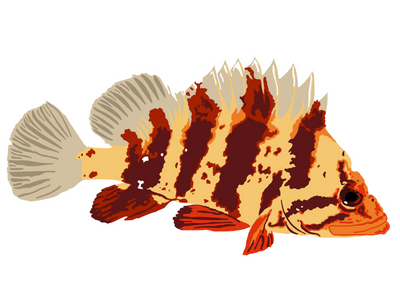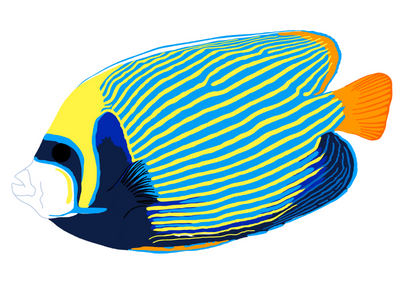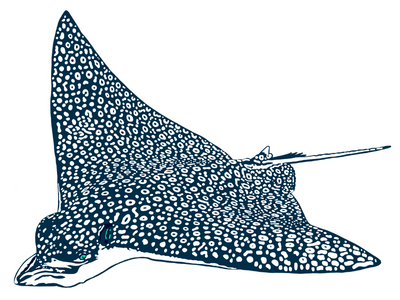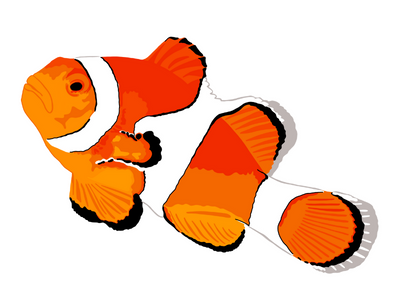
5K Homepage5K FAQsFish ShoalsSocial Media ToolsRegister today!
When you register for the Fish Out of Water Virtual 5K, you choose to join one of the five Fish Teams.
This year’s Fish Teams were selected as some of the most iconic and charismatic species found throughout the REEF Volunteer Fish Survey Project regions worldwide. Whether you are drawn to the fish because it’s a favorite on your life list, you just like the way it looks, it’s often found in the region where you live or dive, or you connect with the personalities we envisioned for each, we look forward to seeing which Fish Team you join.
Click on the fish icons below to read more about each fish’s race “personality” and a few fun facts.
 |
 |
 |
 |
 |

Tiger Rockfish
- Prefers exercising at night
- Loves the thrill of the...race
- Rises up to the challenge
Tiger Rockfish, a shy mostly solitary fish, can be found inhabiting caves, crevices, and other protective recesses throughout the Pacific Northwest. They are distinguished from other Rockfish by their five dark body bars or "tiger stripes." Rockfishes are members of the scorpionfish family, and there are about 60 members of the genus that inhabit the waters of the Pacific coast of North America. They can vary in size from a few inches to a few feet and have venomous spines around their body.

Hammerhead Shark
- Eyes on the prize
- Fueled by hourly protein snacks
- Can't touch this
Hammerhead Sharks get their name from their unusually-shaped heads that are built to help them find their prey and pin it to the seafloor, their favorite being stingrays. Their eye placement on each end of their wide head allows them to scan an area quicker than other predators. Hammerheads can be found around the world, ranging from warm to cool waters. There are 9 species of sharks that fit into the Hammerhead family, with the Great Hammerhead being the largest at an average length of 14 feet.

Emperor Angelfish
- Decked out in the most colorful matching outfits
- Regular in Soul Cycle classes
- Favorite part of working out in the morning is brunch afterward
With vibrant alternating blue and yellow stripes, the Emperor Angelfish is a favorite among many scuba divers. Found in the Indo-Pacific regions of the world, these Angelfish are mostly solitary and can reach over a foot long. Angelfish are typically large, colorful, and graceful fish. Many Angelfish consume sponges, algae, and bottom-dwelling invertebrates. All Angelfish are distinguished by a cheek spine that is found on each of their gill covers. The name Angelfish comes from many of the species having long trailing anal and dorsal fins that resemble and angel's wings.

Spotted Eagle Ray
- Never breaks a sweat
- Always has a smile on their face
- Starts every day with morning yoga and a chai latte
The graceful Spotted Eagle Ray gets its name from the fact that when they are gliding through the water they appear to be "flying." Spotted Eagle Rays are distinguished by their large size, reaching a wingspan sometimes over 8 feet, and their numerous white spots and rings covering their dark back. They can be found worldwide in tropical and warm waters, typically found in open water near shore. This species also is often seen leaping completely out of the water.

Clownfish
- Does jumping jacks at the starting line
- Hype-fish for everyone else
- Loves signing up for 5Ks just to meet new people
Clownfish, otherwise called Anemonefish, are a favorite of many ocean enthusiasts. They are typically smaller fish, usually only reaching a few inches in length, and are often some combination of yellow, orange, red, and black with white markings or stripes. Clownfish are found in warm waters in the Indo-Pacific and can be found living with an anemone in a mutualistic symbiotic relationship in which both species benefit from each other. When hatched, all Clownfish are born as males, and some will transition to females once they mature. Male Clownfish are also the main caretakers of their young.

